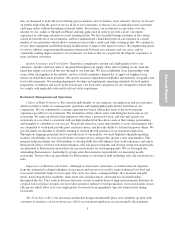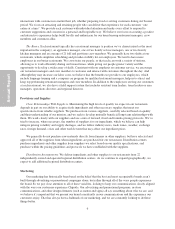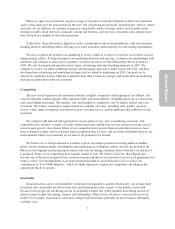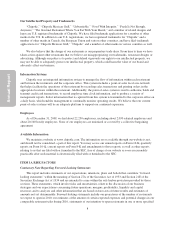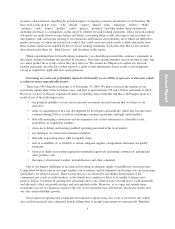Chipotle 2009 Annual Report Download - page 17
Download and view the complete annual report
Please find page 17 of the 2009 Chipotle annual report below. You can navigate through the pages in the report by either clicking on the pages listed below, or by using the keyword search tool below to find specific information within the annual report.
financial condition, results of operations or cash flows could be adversely affected. We currently depend on a
limited number of suppliers for some of our key ingredients, including beef, pork, chicken, beans, rice, sour
cream and tortillas. Due to the unique nature of the products we receive from our Food With Integrity suppliers
and as described in more detail above, these suppliers could be more difficult to replace if we were no longer
able to rely on them. If we have to seek new suppliers and service providers we may be subject to pricing or other
terms less favorable than those we currently enjoy. If we cannot replace or engage distributors or suppliers who
meet our specifications in a short period of time, that could increase our expenses and cause shortages of food
and other items at our restaurants, which could cause a restaurant to remove items from its menu. If that were to
happen and customers change their dining habits as a result, affected restaurants could experience significant
reductions in sales during the shortage or thereafter. Our focus on a limited menu would make the consequences
of a shortage of a key ingredient more severe.
Changes in customer tastes and preferences, spending patterns and demographic trends could cause sales
to decline.
Changes in customer preferences, general economic conditions, discretionary spending priorities,
demographic trends, traffic patterns and the type, number and location of competing restaurants affect the
restaurant industry. Our sales could be impacted by changes in consumer preferences in response to dietary
concerns, including preferences regarding items such as calories, sodium, carbohydrates or fat. These changes
could result in consumers avoiding our menu items in favor of other foods. Our success also depends to a
significant extent on consumer confidence, which is influenced by general economic conditions and discretionary
income levels. Negative consumer sentiment in the wake of the economic downturn was widely reported in 2009
and according to some forecasts will continue during 2010. Our sales may decline during this or future economic
downturns, which can be caused by various factors such as high gasoline prices, declining home prices or tight
credit markets. Any material decline in consumer confidence or a decline in family “food away from home”
spending could cause our sales, operating results, profits, business or financial condition to decline. If we fail to
adapt to changes in customer preferences and trends, we may lose customers and our sales may deteriorate.
Our failure to manage our growth effectively could harm our business and operating results.
Our plans call for a significant number of new restaurants. Our existing restaurant management systems,
financial and management controls and information systems may be inadequate to support our expansion.
Managing our growth effectively will require us to continue to enhance these systems, procedures and controls
and to hire, train and retain restaurant managers and crew. We also are continuing to revise our field management
structure, in an effort to develop additional top-performing restaurant managers more quickly. We may not
respond quickly enough to the changing demands that our expansion will impose on management, crew and
existing infrastructure, and changes to our operating structure may result in increased costs or inefficiencies that
we cannot currently anticipate. Changes as we grow may have a negative impact on the operation of our
restaurants, and cost increases resulting from our inability to effectively manage our growth could adversely
impact our profitability. We also place a lot of importance on our culture, which we believe has been an
important contributor to our success. As we grow, however, we may have difficulty maintaining our culture or
adapting it sufficiently to meet the needs of our operations. Our failure to foster and maintain our corporate
culture could also harm our business and operating results.
Our insurance coverage and self-insurance reserves may not cover future claims.
We maintain various insurance policies for employee health, worker’s compensation, general liability and
property damage. We are self-insured for our health plans, and have purchased a fully-insured stop loss policy to
help offset our liability for both individual and aggregate claim costs. We are also responsible for losses up to a
certain limit for worker’s compensation, general liability and property damage insurance.
For policies under which we are responsible for losses, we record a liability that represents our estimated
cost of claims incurred and unpaid as of the balance sheet date. Our estimated liability is not discounted and is
15
Annual Report


